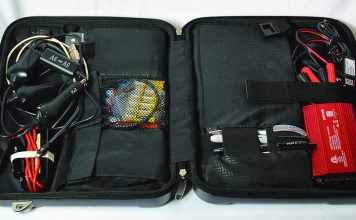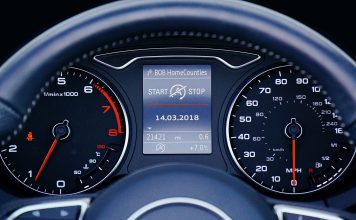 |
|
| Issue #73 • January/February, 2002 |
For less than the price of a desktop computer you can have the piece of mind that your lights and small appliances can operate for months without the utility grid.
It is relatively easy to provide emergency power for most appliances and lighting fixtures with a gasoline generator, but what if the power outage lasts weeks or months instead of days? You may feel prepared owning that 4 kW gasoline generator that you purchased last year to keep your refrigerator, television, and lights operating after storm-downed power lines, but what do you do when you run out of gasoline? What if the gas stations do not have electricity to pump the gasoline and your car’s gas tank is also empty?
|
Most metropolitan areas in the United States rarely experience a power outage that lasts over a few hours. A power outage lasting one or two days during a winter snowstorm or spring hurricane is not uncommon for more rural areas, but very rarely will any part of the United States be without electricity for more than two weeks.
Even when a major hurricane takes down power lines across an entire state, temporary emergency assistance from relief agencies, linemen from unaffected states, rented commercial generators, and other make-do efforts can bring back basic services until all the lines are repaired.
But what if the downed power lines or failed power grid affects a very large part of our country at the same time? What if the damage is so widespread that most homes and businesses will be without power for months, not days? If this widespread grid failure was caused by a terrorist attack or sabotage, we may have more to worry about than beer getting hot in the refrigerator. Under these conditions, remaining in any large city would be almost impossible, but for those living in more rural areas, many will stay home and try to make do. Even a little electric power can bring a lot of needed comfort for these people.
As a basis for this scenario, let us assume you live on several acres of land in a rural area, and you probably already own a wood stove, flashlight, have a well-stocked pantry, and use a well and septic tank. Let’s also assume that even if you own a generator, its gasoline supply is limited and after several days you too will be in the dark if a working gas station is hundreds of miles away. You have just used the last of your candles and flashlight batteries, and are cooking on your wood stove or propane barbeque grille. That all-in-one backup battery power cart you bought at the discount warehouse store was cute, but it only operated your home computer or color television a few hours on the first day of the outage, and now its small battery is also dead. There isn’t a functioning utility grid to recharge your battery-operated appliances, and you now have lost all contact with the outside world.
So now what? What can you do to be prepared for this type of long-term situation without spending your life savings to build that underground bunker with the 5,000-gallon fuel tank or buying a $50,000 solar power system?
Our first step is to identify the absolute minimum electrically powered devices you need to maintain a very basic level of lifestyle during a long-term power outage. Keep in mind that many luxury appliances like color televisions, home computers, refrigerators, electric water heaters, and drip coffee makers will be useless. Even if you could keep them operating, the refrigerator will run out of things to keep cold, the local television stations may be off the air, the downed phone lines will end your Internet surfing (unless you have a satellite connection), and it may be many months before you will have air conditioning and a hot bath again.
|
Let’s start with the basics
Television has a very short range transmission and in rural areas reception is poor beyond 30 to 50 miles from the transmitting tower. Satellite receivers may allow watching distant television channels if they are still operating and you still have emergency power, but a very good all-band radio can receive stations from around the entire world using very little battery consumption. You will want a radio with long range AM band and shortwave reception capability and uses the larger rechargeable C or D cell batteries. Make sure it includes a plug and adapter allowing it to be powered directly from a car’s 12-volt cigarette lighter. The CC radio from the C. Crane Company is an excellent radio for emergencies and costs $159.00. It also receives all emergency alert frequencies and has an optional solar panel to recharge the battery.
Now that you have a reliable window to the outside world, your next concern is lighting up the darkness. For this we turn to the RV and boating industry. If you have not walked into a boating or RV supply store in the past five-years you are in for a surprise. They have any household appliance and light fixture you can imagine, and they all operate from a 12-volt DC battery. I will address in a moment how you will provide this long term 12-volt DC power, so at this point purchase those items you can’t live without and that will operate on 12-volt DC electricity.
Most low cost light fixtures use standard incandescent bulbs that soon burn out and consume too much electricity when used with a small battery backup system. Select lighting fixtures designed for either compact flourescent lamps or the smaller T-8 style 2-foot fluorescent tubes. These provide excellent room lighting, the lamps last several years, and they use very little electricity. If you have electrical skills, buy the 12-volt DC surface-mounted wall sconces and ceiling fixtures. Install these in rooms, corridors, and stairwells where your family spends the majority of their time at night. You can mount them beside your existing 120-volt AC fixtures to achieve the same light distribution.
|
For a more temporary installation, wire each fixture with very long flexible cables of suitable size. Keep the unmounted fixtures and attached rolled up cables stored until needed during a power outage. Be sure you label each light fixture by room location so it will have the correct length of cable back to the battery location.
Do not try to put these 12-volt DC fixtures in every room since you can use a flashlight in any lesser used areas, or just don’t use these spaces after dark. Since you will be powering these DC fixtures from a centrally located battery, your battery wiring must be kept separate from all existing 120-volt AC house wiring. If you purchase DC fixtures that include their own on/off switch, you will not need to wire separate room wall switches, which makes installation much easier. Also keep in mind that at 12-volts, it takes 10 times the number of amps to supply the same wattage light fixture as a 120-volt circuit, so you will need larger wire sizes than normally used for AC circuits.
Follow manufacturer’s installation recommendations for all wiring and wire sizing. Operating kitchen appliances like microwave ovens and refrigerators would make life easier and these larger appliances can be powered from a DC to AC inverter, but this will significantly increase your backup power system’s costs and battery bank size. An inverter large enough to power a refrigerator, medium size microwave oven, or well pump can cost over $3,000 and that still does not include the hundreds of pounds of batteries it requires to operate. If you are interested in installing a whole house off-grid backup power system, refer to the larger solar power systems described in previous issues.
Battery power supply
Since we are limiting your emergency electric needs to only those lights and appliances typically installed in a recreational boat or camper trailer, you do not need to buy a room full of batteries, expensive inverters, sub-panels, and generator transfer switches. If you keep your system needs down to only six or eight high efficiency 12-volt DC fluorescent light fixtures and a quality portable radio or small black and white television, then you will only need a few moderately priced components to build your own long-term backup power system.
|
List of materials:
2 quality gel cell 6-volt batteries-$250
2 solar modules at 50 to 75 watts each-$600
12-volt solar charge controller-$75
2 safety disconnects and fuses-$25
Total: $950
Do not use car batteries as these will not provide the long-term reliability you need.
Remember that this bare bones solar power system is not intended to reduce your electric bills or to replace your existing lights and appliances that you use every day. This will be lighting that only operates during emergencies.
Your best choice for batteries is the 6-volt gel cell golf cart T-105 size battery. Each battery should have a 180-amp hour storage capacity and will weigh about 70 pounds. Their thick lead plates and sealed gel electrolyte will provide very reliable deep discharge capability and require no maintenance or refilling. It can be located almost anywhere; however, ambient temperatures above 90 degrees or below 40 degrees will substantially reduce their storage capacity. Since this is a 6-volt battery, you will need multiples of two in order to provide 12-volt power.
A good rule of thumb is to figure approximately 1 kWh of usable stored electricity in a battery this size. If you keep your electrical loads low, two 6-volt batteries should give you several days of emergency operation before recharging is required. You will not want to operate so many DC lights or appliances that you totally discharge the batteries each night. This will significantly shorten battery life and require a much larger solar array to keep them charged.
For a rough estimate of system performance, assume an average of six hours per day of direct sunlight (9 am to 3 pm), using two 75-watt solar modules, and allow 20% efficiency losses in the battery charging process. This system will have a maximum daily energy collection of 720 watt-hours (75 watt x 2 x 6 hours x 80%). This would power four 25-watt compact fluorescent fixtures for seven hours per night (4 x 25 x 7) plus a radio. It should be obvious that you must keep your electrical loads to a minimum.
|
The more solar modules you have and the larger they are, the more appliances you can power, but since this will be the most expensive item in this system design you will want to keep your load needs small and within budget. For quality solar modules you will normally pay at least $4 to $6 per watt, but with smart shopping you should be able to find a pair of 75-watt modules for under $600.
Shop for the larger 50 to 100-watt modules as these have a lower cost per watt and you will have fewer panels to interconnect. For this size system, a good rule of thumb is one module per golf cart battery. You can mount these on a frame made from 2″ x 2″ aluminum angle and 5/16″ stainless steel bolts purchased from any home supply store. Remember, solar modules will be like kites in a strong wind, and even though they are reasonably lightweight, your structural concerns are wind uplift. A well built mounting structure is worthless if the entire assembly blows away.
Store it away
Since this will be a last defense emergency power system, you could make it portable and store the solar modules in your garage until needed. However, you do not want to allow the gel cell batteries to be discharged for any length of time or they will permanently be unable to hold a full charge later. A high quality trickle charger can be purchased to keep these batteries charged if your solar array will be kept in storage. However, you must use a charger that shuts off when the batteries are fully charged if you plan to keep it permanently plugged in. Also note that any charger used to charge gel cell batteries must be adjustable since gel cell batteries have a different charge voltage than liquid filled batteries.
Whether your solar array will be mounted on a garage roof, van roof, or tall pole, it must face as close to south as possible and tilted up 30 to 60 degrees depending on your latitude.
Charge controller
When shopping for your own solar modules, you will also need to purchase a charge controller. This device controls the battery charging process and a high quality controller will squeeze more charging capacity from any given solar array. Two 75-watt 12-volt modules will require at least a 6-amp charge controller; four modules will require a 12-amp controller. Expect to pay at least $75 for a quality 12-amp unit, and be sure you select a unit with the correct charge voltage output for gel cell batteries.
To round out your system you will need fuses and safety disconnects as shown in the wiring diagram. The Square D QO brand of circuit breakers can be substituted for the fuses shown in the diagram. These are the only AC switchgear you will find in a home improvement center that is also UL rated for use with low voltage DC circuits.
Most AC fuses or circuit breakers are not rated for DC voltages and can be extremely unsafe if used. Purchase only DC-rated fuses and fuse holders. The automotive type 12-volt DC fuses and fuse blocks you will find in the RV and boating supply stores will protect your DC system components; however, they are not UL approved for permanent wiring installation in a residence.
If you are not familiar with these electrical safety issues and the National Electric Code, obtain the assistance of a licensed electrician to help with your final electrical connections.
|
Portability
You may want to have your 12-volt DC lighting and appliance wiring terminate at a common point in a garage or utility room and be able to quickly disconnect the batteries, charge controller, and solar array. This would allow you to relocate your system to an RV or van if you are forced to relocate during a major crises.
The wiring diagram provides a basic guide for connecting the individual components. Be sure to note that the solar modules are nominal 12-volts (they will be labeled 16 to 17-volt) so they must be wired in parallel, not series like the 6-volt batteries or you will end up with 24-volts.
Material sources:
Dunimis Technology Inc., Solar power kit shown, 1-804-784-0063, www.dunimis.com
Port Supply, 12-volt marine appliances, 1-800-621-6885, www.portsupply.com
Lehman’s, Non-electric appliances, 1-888-438-5346, www.lehmans.com
S. King Company, 12-volt RV appliances, 1-888-892-2547, www.skingco.com
RV Parts Outlet, 12- volt RV appliances, 1-866-333-0999, www.rvpartsoutlet.com
C. Crane Company, Battery powered radios, 1-800-522-8863, www.ccrane.com
[weaver_widget_area id=’articles_about_yago’ class=’text3′]



















